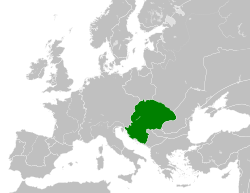ราชอาณาจักรฮังการี
ลิงก์ข้ามภาษาในบทความนี้ มีไว้ให้ผู้อ่านและผู้ร่วมแก้ไขบทความศึกษาเพิ่มเติมโดยสะดวก เนื่องจากวิกิพีเดียภาษาไทยยังไม่มีบทความดังกล่าว กระนั้น ควรรีบสร้างเป็นบทความโดยเร็วที่สุด |
ราชอาณาจักรฮังการี Magyar Királyság | |||||||||||||
|---|---|---|---|---|---|---|---|---|---|---|---|---|---|
| 1000–1918 1920–1946 | |||||||||||||
 ราชอาณาจักรฮังการีในปี 1190 | |||||||||||||
 | |||||||||||||
| สถานะ | ราชอาณาจักร | ||||||||||||
| เมืองหลวง | บูดาเปสต์; พอซโซนี; บูดา; เซแกชแฟเฮร์วาร์; แดแบร็ตแซ็น; เอซเตอร์กอม | ||||||||||||
| ภาษาทั่วไป | ฮังการี, ละติน, เยอรมัน และอื่นๆ | ||||||||||||
| ศาสนา | โรมันคาทอลิก, ต่อมานิกายคาลวิน, ลูเธอรัน และอื่นๆ[1] | ||||||||||||
| การปกครอง | ราชาธิปไตย | ||||||||||||
| พระมหากษัตริย์ | |||||||||||||
• ค.ศ. 1000-1038 | พระเจ้าอิชต์วานที่ 1 | ||||||||||||
• ค.ศ. 1920–1944 | ผู้สำเร็จราชการ มิกโลช โฮร์ตี | ||||||||||||
| Palatine | |||||||||||||
• 1009–1038 | Samuel Aba | ||||||||||||
• 1847–1848 | Stephen Francis Victor | ||||||||||||
| นายกรัฐมนตรี | |||||||||||||
• 1848 | Lajos Batthyány | ||||||||||||
• 1945–1946 | Zoltán Tildy | ||||||||||||
| ประวัติศาสตร์ | |||||||||||||
• ราชาภิเษก พระเจ้าสตีเฟนที่ 1 | ค.ศ. 1000 | ||||||||||||
• ออตโตมันยึดครองบูดา | ค.ศ. 1541 | ||||||||||||
| ค.ศ. 1848 | |||||||||||||
• การประนีประนอมออสเตรีย-ฮังการี | ค.ศ. 1867 | ||||||||||||
| ค.ศ. 1920 | |||||||||||||
| ค.ศ. 1946 | |||||||||||||
| พื้นที่ | |||||||||||||
| 1918 | 325.111 ตารางกิโลเมตร (125.526 ตารางไมล์) | ||||||||||||
| ประชากร | |||||||||||||
• ค.ศ. 1711 | 3000000 | ||||||||||||
• ค.ศ. 1790 | 8000000 | ||||||||||||
• ค.ศ. 1910 | 18264533 | ||||||||||||
• ค.ศ. 1940 | 14679573 | ||||||||||||
| |||||||||||||
ราชอาณาจักรฮังการี หรือเรียกสั้นๆ ว่า ฮังการี (ฮังการี: Magyar Királyság; ละติน: Regnum Hungaria) มีชื่อเต็มว่า “ดินแดนแห่งมงกุฎนักบุญอิชต์วาน”[4][5][6] (ฮังการี: A magyar Szent Korona országai) เริ่มก่อตั้งราชอาณาจักรขึ้นราว ค.ศ. 1000 เมื่อราชรัฐฮังการีที่ก่อตั้งในปี ค.ศ. 896 ได้รับฐานะเป็น “ราชอาณาจักร” โครงสร้างของการปกครองเปลี่ยนแปลงจากระบอบสมบูรณาญาสิทธิราชย์ไปเป็นระบอบสาธารณรัฐเป็นระยะเวลาอันสั้นใน ค.ศ. 1918 และอีกครั้งหนึ่งใน ค.ศ. 1946 ซึ่งเป็นการสิ้นสุดของการเป็นราชอาณาจักรและเปลี่ยนไปเป็นสาธารณรัฐฮังการี ในประวัติศาสตร์ส่วนใหญ่ราชอาณาจักรฮังการีถือว่าเป็นรัฐหนึ่งของยุโรปกลางที่นอกจากตัวราชอาณาจักรแล้วก็ยังรวมทรานซิลเวเนีย โครเอเชีย-สโลวีเนีย และดินแดนที่เรียกว่าพรมแดนทหาร (Military Frontier)[7]
ชื่อ[แก้]
ต้นกำเนิด[แก้]
เมืองหลวง[แก้]
| เมืองหลวง | ค.ศ. |
|---|---|
| เซแก็ชแฟเฮร์วาร์ (Székesfehérvár) | 1000–1543 |
| แอ็สแตร์โกม (Esztergom) | 1000–1256 |
| บูดอ (Buda) | 1256–1315 |
| แตแม็ชวาร์ (Temesvár) (ปัจจุบันคือ เมืองตีมีชวารา Timișoara ประเทศโรมาเนีย) | 1315–1323 |
| วิแชกราด (Visegrád) | 1323–1408 |
| บูดอ (Buda) | 1408–1485 |
| เบช (Bécs) (ปัจจุบันคือ กรุงเวียนนา Wien เมืองหลวงของประเทศออสเตรีย) | 1485–1490 |
| บูดอ (Buda) | 1490–1536 (1541) |
| ลิปปอ (Lippa ปัจจุบันคือ เมืองลิโปวา Lipova ประเทศโรมาเนีย) – ราชอาณาจักรฮังการีตะวันออก | 1541–1542 |
| จยูลอแฟเฮร์วาร์ (Gyulafehérvár ปัจจุบันคือ เมืองอัลบายูเลีย Alba Iulia ประเทศโรมาเนีย) – ราชอาณาจักรฮังการีตะวันออก | 1542–1570 |
| โปโจญ (Pozsony ปัจจุบันคือ กรุงบราติสลาวา Bratislava เมืองหลวงของประเทศสโลวาเกีย) | 1536–1784 |
| บูดอ (Buda) | 1784–1849 |
| แดแบร็ตแซ็น (Debrecen) | 1849 |
| บูดอ (Buda) | 1849–1873 |
| บูดาเปสต์ (Budapest) | 1873–1944 |
| แดแบร็ตแซ็น (Debrecen) | 1944 |
| บูดาเปสต์ (Budapest) | 1944–1946 |
ยุคกลาง[แก้]
ยุคกลางตอนต้น[แก้]
จักรวรรดิมองโกล[แก้]
ยุคกลางตอนปลาย[แก้]
ศตวรรษที่ 16-19[แก้]
ศตวรรษที่ 20[แก้]
ออสเตรีย-ฮังการี[แก้]
ค.ศ. 1920–1946[แก้]
ดูเพิ่ม[แก้]
อ้างอิง[แก้]
- ↑ และอีสเติร์นออร์โธด็อกซ์, ยูนิทาเรียน, ยูดาย
- ↑ Historical World Atlas. With the commendation of the Royal Geographical Society. Carthographia, Budapest, Hungary, 2005. ISBN 963-352-002-9CM
- ↑ The majority of Hungarian people became Christian in the 10th century.Hungary's first king, Stephen I of Hungary, took up Western Christianity. Hungary remained Catholic until the 16th century, when the Protestant Reformation took place and, as a result, first Lutheranism, then soon afterwards Calvinism started to spread.
- ↑ Peter Revay: Commentarius De Sacra Regni Hungariae Corona, "Commentary on the Kingdom of the Holy Crown of Hungary" 1613.
- ↑ Peter Revay: "About the state of Hungary and the Holy Hungarian Crown( of St. Stephen)", 1613
- ↑ Engel, Pal; Palosfalvi, Tamas; Ayton, Andrew (2005). The Realm of St Stephen (illustrated ed.). I.B.Tauris. ISBN 185043977X, 9781850439776. สืบค้นเมื่อ 02-16-2009.
{{cite book}}: ตรวจสอบค่า|isbn=: ตัวอักษรไม่ถูกต้อง (help); ตรวจสอบค่าวันที่ใน:|accessdate=(help) - ↑ Aldásy, Antal. "Hungary." The Catholic Encyclopedia. Vol. 7. New York: Robert Appleton Company, 1910. 17 Apr. 2009 <http://www.newadvent.org/cathen/07547a.htm>.
หนังสืออ่านเพิ่มเติม[แก้]
- Frucht, Richard. Encyclopedia of Eastern Europe: From the Congress of Vienna to the Fall of Communism (2000) online edition
- Hoensch, Jörg K., and Kim Traynor. A History of Modern Hungary, 1867–1994 (1996) online edition
- Hanak, Peter et al. A History of Hungary (1994)
- Kontler, Laszlo. A History of Hungary (2006) excerpt and text search
- Molnár, Miklós, and Anna Magyar. A Concise History of Hungary (2001) excerpt and text search
- Palffy, Geza. The Kingdom of Hungary and the Habsburg Monarchy in the Sixteenth Century (East European Monographs, distributed by Columbia University Press, 2010) 406 pages; Covers the period after the battle of Mohacs in 1526 when the Kingdom of Hungary was partitioned in three, with one segment going to the Habsburgs.
แหล่งข้อมูลอื่น[แก้]
วิกิมีเดียคอมมอนส์มีสื่อที่เกี่ยวข้องกับ ราชอาณาจักรฮังการี


